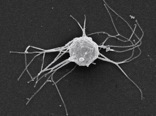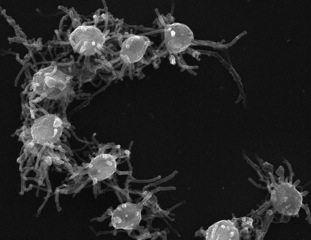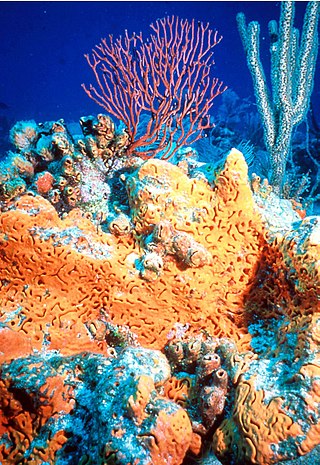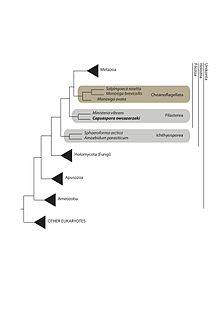
Nucleariida is a group of amoebae with filose pseudopods, known mostly from soils and freshwater. They are distinguished from the superficially similar vampyrellids mainly by having mitochondria with discoid cristae, in the absence of superficial granules, and in the way they consume food.

The opisthokonts are a broad group of eukaryotes, including both the animal and fungus kingdoms. The opisthokonts, previously called the "Fungi/Metazoa group", are generally recognized as a clade. Opisthokonts together with Apusomonadida and Breviata comprise the larger clade Obazoa.

The Rhizaria are a diverse and species-rich supergroup of mostly unicellular eukaryotes. Except for the Chlorarachniophytes and three species in the genus Paulinella in the phylum Cercozoa, they are all non-photosynthethic, but many foraminifera and radiolaria have a symbiotic relationship with unicellular algae. A multicellular form, Guttulinopsis vulgaris, a cellular slime mold, has been described. This group was used by Cavalier-Smith in 2002, although the term "Rhizaria" had been long used for clades within the currently recognized taxon. Being described mainly from rDNA sequences, they vary considerably in form, having no clear morphological distinctive characters (synapomorphies), but for the most part they are amoeboids with filose, reticulose, or microtubule-supported pseudopods. In the absence of an apomorphy, the group is ill-defined, and its composition has been very fluid. Some Rhizaria possess mineral exoskeletons, which are in different clades within Rhizaria made out of opal, celestite, or calcite. Certain species can attain sizes of more than a centimeter with some species being able to form cylindrical colonies approximately 1 cm in diameter and greater than 1 m in length. They feed by capturing and engulfing prey with the extensions of their pseudopodia; forms that are symbiotic with unicellular algae contribute significantly to the total primary production of the ocean.

The Apusozoa are a paraphyletic phylum of flagellate eukaryotes. They are usually around 5–20 μm in size, and occur in soils and aquatic habitats, where they feed on bacteria. They are grouped together based on the presence of an organic shell or theca under the dorsal surface of the cell.
The Urmetazoan is the hypothetical last common ancestor of all animals, or metazoans. It is universally accepted to be a multicellular heterotroph — with the novelties of a germline and oogamy, an extracellular matrix (ECM) and basement membrane, cell-cell and cell-ECM adhesions and signaling pathways, collagen IV and fibrillar collagen, different cell types, spatial regulation and a complex developmental plan, and relegated unicellular stages.

Ministeria vibrans is a bacterivorous amoeba with filopodia that was originally described to be suspended by a flagellum-like stalk attached to the substrate. Molecular and experimental work later on demonstrated the stalk is indeed a flagellar apparatus.

Breviata anathema is a single-celled flagellate amoeboid eukaryote, previously studied under the name Mastigamoeba invertens. The cell lacks mitochondria, much like the pelobionts to which the species was previously assigned, but has remnant mitochondrial genes, and possesses an organelle believed to be a modified anaerobic mitochondrion, similar to the mitosomes and hydrogenosomes found in other eukaryotes that live in low-oxygen environments.

Filasterea is a proposed basal Filozoan clade of single-celled ameboid eukaryotes that includes Ministeria and Capsaspora. It is a sister clade to the Choanozoa in which the Choanoflagellatea and Animals appeared, originally proposed by Shalchian-Tabrizi et al. in 2008, based on a phylogenomic analysis with dozens of genes. Filasterea was found to be the sister-group to the clade composed of Metazoa and Choanoflagellata within the Opisthokonta, a finding that has been further corroborated with additional, more taxon-rich, phylogenetic analyses.

Holozoa is a clade of organisms that includes animals and their closest single-celled relatives, but excludes fungi and all other organisms. Together they amount to more than 1.5 million species of purely heterotrophic organisms, including around 300 unicellular species. It consists of various subgroups, namely Metazoa and the protists Choanoflagellata, Filasterea, Pluriformea and Ichthyosporea. Along with fungi and some other groups, Holozoa is part of the Opisthokonta, a supergroup of eukaryotes. Choanofila was previously used as the name for a group similar in composition to Holozoa, but its usage is discouraged now because it excludes animals and is therefore paraphyletic.

The apusomonads are a group of protozoan zooflagellates that glide on surfaces, and mostly consume prokaryotes. They are of particular evolutionary interest because they appear to be the sister group to the Opisthokonts, the clade that includes both animals and fungi. Together with the Breviatea, these form the Obazoa clade.

The Filozoa are a monophyletic grouping within the Opisthokonta. They include animals and their nearest unicellular relatives.

Holomycota or Nucletmycea are a basal Opisthokont clade as sister of the Holozoa. It consists of the Cristidiscoidea and the kingdom Fungi. The position of nucleariids, unicellular free-living phagotrophic amoebae, as the earliest lineage of Holomycota suggests that animals and fungi independently acquired complex multicellularity from a common unicellular ancestor and that the osmotrophic lifestyle was originated later in the divergence of this eukaryotic lineage. Opisthosporidians is a recently proposed taxonomic group that includes aphelids, Microsporidia and Cryptomycota, three groups of endoparasites.

Choanozoa is a clade of opisthokont eukaryotes consisting of the choanoflagellates (Choanoflagellatea) and the animals. The sister-group relationship between the choanoflagellates and animals has important implications for the origin of the animals. The clade was identified in 2015 by Graham Budd and Sören Jensen, who used the name Apoikozoa. The 2018 revision of the classification first proposed by the International Society of Protistologists in 2012 recommends the use of the name Choanozoa.

Creolimax fragrantissima is a single-celled protist that occupies a key phylogenetic position to understand the origin of animals. It was isolated from the digestive tract of some marine invertebrates, mainly from the peanut worm, collected from the Northeast Pacific.

Sphaeroforma arctica, is a unicellular eukaryote with a pivotal position in the tree of life. It was first isolated from the arctic marine amphipod Gammarus setosus. Like other Ichthyosporeans such as Creolimax and Abeoforma, Sphaeroforma arctica are spherical cells characterized with their capacity to grow into multi-nucleated coenocytes. However, a unique feature of S. arctica, is that no obvious budding, hyphal, amoeboid, sporal or flagellated growth stages have been observed in laboratory growth conditions.
Mantamonads are a group of free-living heterotrophic flagellates that move primarily by gliding on surfaces. They are classified as one genus Mantamonas in the monotypic family Mantamonadidae, order Mantamonadida and class Glissodiscea. Previously, they were classified in Apusozoa as sister of the Apusmonadida on the basis of rRNA analyses. However, mantamonads are currently placed in CRuMs on the basis of phylogenomic analyses that identify their closest relatives as the Diphylleida and Rigifilida.

Parvularia atlantis is a filopodiated amoeba which was isolated from a lake in Atlanta and deposited in the American Type Culture Collection (ATCC) under the name Nuclearia sp. ATCC 50694 on 1997 by TK Sawyer. It was classified under the genus Nuclearia and morphologically resembles to Nuclearia species, although it is smaller. Later it was determined that it phylogenetically belongs to a new nucleariid lineage., distantly related to Nuclearia and Fonticula genera – the other two previously described nucleriid genera.
Tunicaraptor is a genus of marine microbial protists containing the single species Tunicaraptor unikontum, discovered in 2020 from marine waters of Chile. It is a lineage of predatorial flagellates closely related to animals. It has a rare feeding structure not seen in other opisthokonts.

Syssomonas is a monotypic genus of unicellular flagellated protists containing the species Syssomonas multiformis. It is a member of Pluriformea inside the lineage of Holozoa, a clade containing animals and their closest protistan relatives. It lives in freshwater habitats. It has a complex life cycle that includes unicellular amoeboid and flagellated phases, as well as multicellular aggregates, depending on the growth medium and nutritional state.

An amoeboflagellate is any eukaryotic organism capable of behaving as an amoeba and as a flagellate at some point during their life cycle. Amoeboflagellates present both pseudopodia and at least one flagellum, often simultaneously.

















